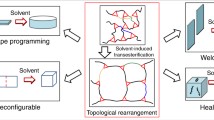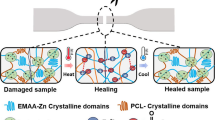Abstract
Self-repair properties based on shape-memory features of covalently crosslinked semi-crystalline polyalkenamers were demonstrated by thermal-activated recovery of performed surface marks (indented holes and scratches). Shape memory polymers were prepared by mixing a commercial polycyclooctene (PCO) with different percentages of peroxide, and then these mixtures were processed by compression moulding to obtain crosslinked sheets. With the aid of a hardness test pencil, holes and scratches in the surface of the materials were realized with different known forces (5, 10 and 15 N). The disappearance of surface defects was evaluated using both optical and contact surface profilometry, as well as optical microscopy under heating processes. This technique allowed evaluating shape recovery ratios of edgewise holes in PCO samples. In parallel, the analysis of maximum depth of indentations with temperature for edgewise samples by optical microscopy allows evaluating shape recovery. As a complementary tool for analysing thermal shape-recovery and surface resistance to indentation, thermal properties and hardness were investigated by DSC and Shore durometer test, respectively.













Similar content being viewed by others
References
Schmets AJM, van der Zaken G, van der Zwaag S (2007) Self healing materials: an alternative approach to 20 centuries of materials science. Springer, Dordrecht
Wu DY, Meure S, Solomon D (2008) Self-healing polymeric materials: A review of recent developments. Prog Polym Sci 33:479–522. doi: http://dx.doi.org/10.1016/j.progpolymsci.2008.02.001
White SR, Sottos NR, Geubelle PH et al (2001) Autonomic healing of polymer composites. Nature 409:794–797. doi:10.1038/35057232
Rule JD, Brown EN, Sottos NR et al (2005) Wax-protected catalyst microspheres for efficient self-healing materials. Adv Mater 17:205–208. doi:10.1002/adma.200400607
Cho SH, Andersson HM, White SR et al (2006) Polydimethylsiloxane-based self-healing materials. Adv Mater 18:997–1000. doi:10.1002/adma.200501814
Gupta S, Zhang Q, Emrick T et al (2006) Entropy-driven segregation of nanoparticles to cracks in multilayered composite polymer structures. Nat Mater 5:229–233. doi:10.1038/nmat1582
Kolmakov GV, Matyjaszewski K, Balazs AC (2009) Harnessing labile bonds between nanogel particles to create self-healing materials. ACS Nano 3:885–892. doi:10.1021/nn900052h
Toohey KS, Sottos NR, Lewis JA, et al. (2007) Self-healing materials with microvascular networks. Nat Mater 6:581–585. doi:http://www.nature.com/nmat/journal/v6/n8/suppinfo/nmat1934_S1.html
Toohey KS, Hansen CJ, Lewis JA et al (2009) Delivery of Two-part self-healing chemistry via microvascular networks. Adv Funct Mater 19:1399–1405. doi:10.1002/adfm.200801824
Hansen CJ, Wu W, Toohey KS et al (2009) Self-healing materials with interpenetrating microvascular networks. Adv Mater 21:4143–4147. doi:10.1002/adma.200900588
South AB, Lyon LA (2010) Autonomic self-healing of hydrogel thin films. Angew Chemie 122:779–783. doi:10.1002/ange.200906040
Mukhopadhyay P, Fujita N, Takada A et al (2010) Regulation of a real-time self-healing process in organogel tissues by molecular adhesives. Angew Chemie Int Ed 49:6338–6342. doi:10.1002/anie.201001382
Amamoto Y, Kamada J, Otsuka H et al (2011) Repeatable photoinduced self-healing of covalently cross-linked polymers through reshuffling of trithiocarbonate units. Angew Chemie 123:1698–1701. doi:10.1002/ange.201003888
He L, Fullenkamp DE, Rivera JG, Messersmith PB (2011) pH responsive self-healing hydrogels formed by boronate – catechol complexation. Chem Commun 47:7497–7499. doi:10.1039/c1cc11928a
Lai S-M, Lan Y-C (2013) Shape memory properties of melt-blended polylactic acid (PLA)/thermoplastic polyurethane (TPU) bio-based blends. J Polym Res 20:1–8. doi:10.1007/s10965-013-0140-6
Schmidt C, Sarwaruddin Chowdhury AM, Neuking K, Eggeler G (2011) Thermo-mechanical behaviour of shape memory polymers, e.g., tecoflex® by 1WE method: SEM and IR analysis. J Polym Res 18:1807–1812. doi:10.1007/s10965-011-9587-5
Revathi A, Rao S, Rao KV (2013) Effect of strain on the thermomechanical behavior of epoxy based shape memory polymers. J Polym Res 20:113. doi:10.1007/s10965-013-0113-9
Biju R, Nair CPR (2013) Synthesis and characterization of shape memory epoxy-anhydride system. J Polym Res 20:1–11. doi:10.1007/s10965-013-0082-z
Kavitha, Revathi A, Rao S et al (2012) Characterization of shape memory behaviour of CTBN-epoxy resin system. J Polym Res 19:1–7. doi:10.1007/s10965-012-9894-5
Lendlein A, Kelch S (2002) Shape-memory polymers. Angew Chemie Int Ed 41:2034–2057. doi:10.1002/1521-3773(20020617)41:12<2034::aid-anie2034>3.0.co;2-m
Liu C, Qin H, Mather PT (2007) Review of progress in shape-memory polymers. J Mater Chem 17:1543–1558. doi:10.1039/b615954k
Amirian M, Nabipour Chakoli A, Sui J, Cai W (2012) Enhanced shape memory effect of poly(L-lactide-co-ε-caprolactone) biodegradable copolymer reinforced with functionalized MWCNTs. J Polym Res 19:1–10. doi:10.1007/s10965-011-9777-1
El Feninat F, Laroche G, Fiset M, Mantovani D (2002) Shape memory materials for biomedical applications. Adv Eng Mater 4:91–104. doi:10.1002/1527-2648(200203)4:3<91::AID-ADEM91>3.0.CO;2-B
Wang Y, Zhu G, Tang Y et al (2014) Mechanical and shape memory behavior of chemically cross-linked SBS/LDPE blends. J Polym Res 21:1–10. doi:10.1007/s10965-014-0405-8
Alonso-Villanueva J, Cuevas JM, Laza JM et al (2010) Synthesis of poly(cyclooctene) by ring-opening metathesis polymerization: characterization and shape memory properties. J Appl Polym Sci 115:2440–2447. doi:10.1002/app.29394
Xie T (2011) Recent advances in polymer shape memory. Polymer 52:4985–5000. doi: http://dx.doi.org/10.1016/j.polymer.2011.08.003
Rodriguez ED, Luo X, Mather PT (2011) Linear/network poly(ε-caprolactone) blends exhibiting shape memory assisted self-healing (SMASH). ACS Appl Mater Interfaces 3:152–161. doi:10.1021/am101012c
Wang W, Jin Y, Ping P et al (2010) Structure evolution in segmented poly(ester urethane) in shape-memory process. Macromolecules 43:2942–2947. doi:10.1021/ma902781e
Ping P, Wang W, Chen X, Jing X (2005) Poly(ε-caprolactone) polyurethane and its shape-memory property. Biomacromolecules 6:587–592. doi:10.1021/bm049477j
Xiao X, Xie T, Cheng Y-T (2010) Self-healable graphene polymer composites. J Mater Chem 20:3508–3514. doi:10.1039/c0jm00307g
Li G, Nettles D (2010) Thermomechanical characterization of a shape memory polymer based self-repairing syntactic foam. Polymer 51:755–762. doi:10.1016/j.polymer.2009.12.002
Cuevas JM, Laza JM, Rubio R et al (2011) Development and characterization of semi-crystalline polyalkenamer based shape memory polymers. Smart Mater Struct 20:035003/1–035003/9. doi:10.1088/0964-1726/20/3/035003
Khonakdar HA, Jafari SH, Rasouli S et al (2007) Investigation and modeling of temperature dependence recovery behavior of shape-memory crosslinked polyethylene. Macromol Theory Simul 16:43–52. doi:10.1002/mats.200600041
Rezanejad S, Kokabi M (2007) Shape memory and mechanical properties of cross-linked polyethylene/clay nanocomposites. Eur Polym J 43:2856–2865. doi: http://dx.doi.org/10.1016/j.eurpolymj.2007.04.031
Li F, Zhu W, Zhang X et al (1999) Shape memory effect of ethylene–vinyl acetate copolymers. J Appl Polym Sci 71:1063–1070. doi:10.1002/(sici)1097-4628(19990214)71:7<1063::aid-app4>3.0.co;2-a
Liu C, Chun SB, Mather PT et al (2002) Chemically cross-linked polycyclooctene: synthesis, characterization, and shape memory behavior. Macromolecules 35:9868–9874. doi:10.1021/ma021141j
Liu C, Mather PT (2002) Thermomechanical characterization of a tailored series of shape memory polymers. J Appl Med Polym 6:47–52
Mather PT, Liu C, Chun SB, Coughlin EB (2007) Patent US7173096 B2
Lendlein A (2007) Pat. WO 2007/060022 A1
Cuevas JM, Rubio R, Laza JM et al (2012) Shape memory composites based on glass-fibre-reinforced poly(ethylene)-like polymers. Smart Mater Struct 21:035004/1–035004/9. doi:10.1088/0964-1726/21/3/035004
Cuevas JM, Alonso J, German L, et al. (2009) Magneto-active shape memory composites by incorporating ferromagnetic microparticles in a thermo-responsive polyalkenamer. Smart Mater Struct 18:075003/1–075003/10. doi: 10.1088/0964-1726/18/7/075003
Cuevas JM, Rubio R, German L et al (2012) Triple-shape memory effect of covalently crosslinked polyalkenamer based semicrystalline polymer blends. Soft Matter 8:4928–4935. doi:10.1039/c2sm07481h
Céspedes RIN, Gámez JFH, Velázquez MGN et al (2014) Thermoplastic elastomers based on high-density polyethylene, ethylene–propylene–diene terpolymer, and ground tire rubber dynamically vulcanized with dicumyl peroxide. J Appl Polym Sci 131:39901/1–39901/8. doi:10.1002/app.39901
Nakayama K, Watanabe T, Ohtake Y, Furukawa M (2008) Influence of residual peroxide on the degradation of peroxide-crosslinked ethylene–propylene–diene rubber. J Appl Polym Sci 108:2578–2586. doi:10.1002/app.27894
Baltá-Calleja EJ, Kilian HG (1985) A novel concept in describing elastic and plastic properties of semicrystalline polymers: polyethylene. Colloid Polym Sci 263:697–707. doi:10.1007/BF01422850
Deslandes Y, Rosa EA, Brisse F, Meneghini T (1991) Correlation of micro hardness and morphology of poly (ether-ether-ketone) films. J Mater Sci 26:2769–2777. doi:10.1007/BF00545567
Calleja FJB, Salazar JM, Čačković H, Loboda-Čačković J (1981) Correlation of hardness and microstructure in unoriented lamellar polyethylene. J Mater Sci 16:739–751. doi:10.1007/BF02402791
Acknowledgments
The authors would like to acknowledge Basque Country Government (ACTIMAT project from ETORTEK programme) for the financial support.
Author information
Authors and Affiliations
Corresponding author
Rights and permissions
About this article
Cite this article
García-Huete, N., Laza, J.M., Cuevas, J.M. et al. Shape memory effect for recovering surface damages on polymer substrates. J Polym Res 21, 481 (2014). https://doi.org/10.1007/s10965-014-0481-9
Received:
Accepted:
Published:
DOI: https://doi.org/10.1007/s10965-014-0481-9




